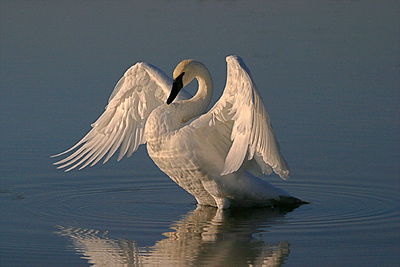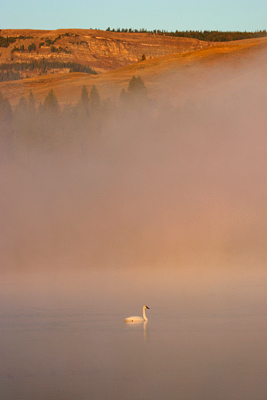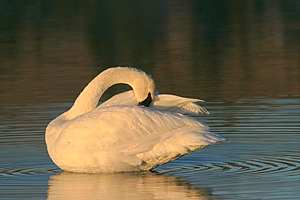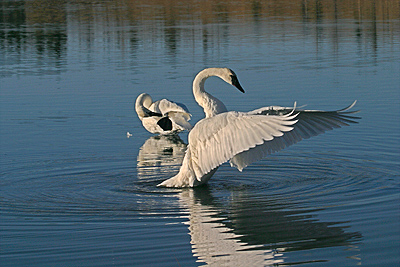|
 The
cry is deep and loud, resonant and sonorous, and sounds like a
trumpet. Hence the name, Trumpeter Swan. The rarest of swans and
the largest waterfowl species native to North America, the Trumpeter
Swan is a manifest of nature's beauty and grace. The
cry is deep and loud, resonant and sonorous, and sounds like a
trumpet. Hence the name, Trumpeter Swan. The rarest of swans and
the largest waterfowl species native to North America, the Trumpeter
Swan is a manifest of nature's beauty and grace.
The adult
trumpeter swan is all white and has a broad, flat bill with a
red stripe along the edge of the lower mandible. The bill has
fine tooth-like serrations along the edges that strain water
when the bird feeds on aquatic vegetation. Its long neck allows
the swan to uproot plants in 4 feet of water. Sometimes there is
a rust tint on the head and neck because of iron in the water.
|
|
|
 Male
swans are called "cobs", female swans are
"pens", and young swans up to 1 year of age are
"cygnets". In a standing position, an adult swan is
about 4 ft. high and the wingspan is between 6 to 8 feet. Its
defense mechanism is striking predators with those powerful
wings. The adult male typically weighs between 26 to 30
lbs. and the female averages at about 21 to 22 lbs. Trumpeter
swans mate for life and may live for 20 to 30 years. If one
member of a pair dies, the survivor usually finds another mate. Male
swans are called "cobs", female swans are
"pens", and young swans up to 1 year of age are
"cygnets". In a standing position, an adult swan is
about 4 ft. high and the wingspan is between 6 to 8 feet. Its
defense mechanism is striking predators with those powerful
wings. The adult male typically weighs between 26 to 30
lbs. and the female averages at about 21 to 22 lbs. Trumpeter
swans mate for life and may live for 20 to 30 years. If one
member of a pair dies, the survivor usually finds another mate.
Each
year the adult swan goes through a period of molting all its
feathers making it flightless for 1 to 2 months. This usually
occurs during the warmest months of July and August.
Large
areas of shallow water with vegetation such as bulrushes, sedges
and cattails are common nesting areas for trumpeter swans. Nests
are built on top of former muskrat and beaver lodges or on
mounds of vegetation. Trumpeter swans breed from as early as 2
years of age, usually laying 5 creamy white eggs from between
April to June. The eggs incubate about 32 days and the young
fledge at about 14 weeks.
Preening
is vital to maintaining the bird's plumage. When preening, the
swan presses its bill against an oil gland located at the base
of the tail to extract a greasy fluid which is used to clean,
recondition and waterproof the feathers.
|
|
|
 Trumpeter swans were hunted for their meat and feathers during
the 19th century and by 1900, it was widely believed that the
species had become extinct. Fortunately, several small isolated
populations were found in remote areas of Montana, Idaho,
Wyoming, Alaska and Canada. With the help of government
protection established in 1935 and several restoration programs
in various states, the population has increased to a level where
the swans are now no longer listed as threatened or endangered.
However in some parts of the country, the trumpeter swan is more
rare than the bald eagle, and there still are several threats to
the continued existence of this species.
Trumpeter swans were hunted for their meat and feathers during
the 19th century and by 1900, it was widely believed that the
species had become extinct. Fortunately, several small isolated
populations were found in remote areas of Montana, Idaho,
Wyoming, Alaska and Canada. With the help of government
protection established in 1935 and several restoration programs
in various states, the population has increased to a level where
the swans are now no longer listed as threatened or endangered.
However in some parts of the country, the trumpeter swan is more
rare than the bald eagle, and there still are several threats to
the continued existence of this species.
|
|
|
 Shooting remains a
problem because hunters mistake trumpeter swans for snow geese.
Lead poisoning from the ingestion of spent shots and fishing
sinkers is another problem. Trumpeter swans are highly sensitive
to lead poisoning and just 1 to 2 lead pellets can sicken or
kill them. People who choose to hunt should use non-toxic
ammunition such as steel shots, bismuth shots, tin shots,
tungsten-matrix, tungsten-iron and tungsten-polymer shots.
Although more expensive than lead shots, this is a small price
to pay for preserving non-target species such as the trumpeter
swan. Shooting remains a
problem because hunters mistake trumpeter swans for snow geese.
Lead poisoning from the ingestion of spent shots and fishing
sinkers is another problem. Trumpeter swans are highly sensitive
to lead poisoning and just 1 to 2 lead pellets can sicken or
kill them. People who choose to hunt should use non-toxic
ammunition such as steel shots, bismuth shots, tin shots,
tungsten-matrix, tungsten-iron and tungsten-polymer shots.
Although more expensive than lead shots, this is a small price
to pay for preserving non-target species such as the trumpeter
swan.
|
|